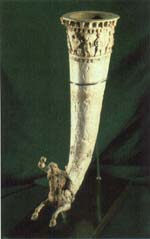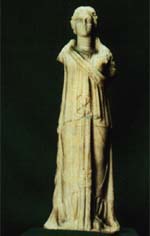
Turkmenistan's National Museum was "born" on the
January, 5, 1998. On that day the President of the country
signed a statement setting out its future. The construction of
the building was already completed, but work to equip the interior and shape its displays was still to come. The museum
traces its roots back to the XIX century and a small amateur
collection of household artifacts and examples of Turkmen
workmanship which were displayed at the Russian industrial
exhibition in Nizhni Novgorod in 1896. The exhibits were
returned to Ashkhabad and used to found the Transcaspian
Regional Museum, 100 years ago, on of March, 17, 1899. It
soon became the single centre for the study of local nature,
ethnography and history, with natural history as its main direction for a long time.
As the years passed, the museum changed names and
moved from one place to another. But what was badly needed
was a venue where the exhibits could be shown off to their best
advantage, free of any provincial cramming and squalor.
Priceless treasures were kept for decades in storage conditions which, politely speaking, left much to be desired. No-one
knows how many rare exhibits were lost during this period,
when museum funds were disorganised and restoration of
artefacts was non-existent. But this was only part of the problem. The museums of Turkmenistan were unable to become
museums in the full sense of the word. They were simply warehouses packed with exhibits, or modest collections, a far cry
from being scientific centres or "temples of the muses".
That the real "temple" has been built only now, towards the
end of the century, is to a large extent due to the vision of
President Saparmurat Turkmenbashi, who helped plan the
project from its conception through to its layout and facilities.
According to the ideas of the head of state, embodied in the
work of Turkish architect Jan Onai, this unusual structure was
built on a high site in Berzengi — a new business district in the
south of Ashkhabad, near the picturesque foothills of
Kopetdag. The supermodern complex of 30 000 square
meters was erected by the Turkish firm «Uchgen» in record
time. Just one and one-half years passed between the laying
of the foundation stone and completion of the project.

Anyone approaching the museum for the first time is confronted with a three-story building, crowned by a central heavenly-blue dome consisting of 16 semi-spherical sides, each
symbolizing one of the Turkic states founded over the centuries. The dome is supported by five 19-meter pillars - symbolizing the number of velayats (districts) in the country. The
vertical atrium emphasises their height (19 meters). On the
roof, five small light-blue domes surround a central dome. At
the museum's entrance, five small fountains surround a larger
one at the centre of a square.
On the first floor, on both sides of the central entrance there
are four conference halls, and outside are four summer
amphitheaters intended for drama productions, which adjoin
the building on its different sides.
Inside, the architect chose Finnish granite and bronze for
decorating the bases and caps of pillars. For facing the
facades and external galleries, uniy stone — a strong and
beautiful material from Turkey, — is used. The museum's complex engineering system includes independent emergency
power and water supplies, electronic temperature and humidity regulation, and a reliable security system. In a word, every
care has been taken to ensure that Turkmenistan's invaluable
relics are housed safely. Now they are accessible for everybody, and visitors can view its galleries and halls at their
leisure, enjoying the full spectrum of the national culture.
Let's take a small excursion through the museum and its
halls.
On the first floor, to the left of the centre of the building,
where a sculpure of the state emblem is installed on a high
foundation, is the
HALL OF INDEPENDENCE,
illustrating the modern development of the country, along with a range of
costly presents given to Saparmurat Turkmenbashi, and
donated by him to the museum.
The second floor is entirely dedicated to archaeology and
ethnography. The first three halls feature displays in chronological order.
THE HALL OF ANCIENT HISTORY presents a
collection of flint tools from the Mezolithic era (50 000 years
B.C.), used by primitive people in Western Turkmenistan,
along with Neolithic ceramics and ornaments from the first
human settlements along the northern slopes of Kopetdag.
There are also objects made from clay and metal, semi-precious stones and bone, witnessing the high level of development of the early agricultural civilizations of Jeitun, Altyn-Dep,
Namazg, Anau etc. They represent the northern complex of
old-eastern culture most famous in Babylon and Assyria.
The place of honor in this hall is occupied by Margiana, a
unique Bronze Age civilization discovered by archaeologists in
the Karakum desert to the north of the modern town of
Bairamali, which was a fertile delta of the river Murgab about
3000 years ago. There was a set of settlements with mighty
towers and monumental sanctuaries.
THE HALL OF ANTIQUITY covers the eventful period of history from the Akheminidic period (VI-IV centuries B.C.) to the
first centuries A.D. Parphian culture 11-1 cent. B.C. dominates
here, which became the largest empire of the East, competing
with Rome itself.


A full collection of ritons — special horn-like vessels made
of ivory featuring magnificent art-are represented alongside a
number of other exhibits. All of them were found in
Ashkhabad's suburbs, at excavations of Old Nisa — residence
of Parphian kings from the Arshakid Dynasty. Marble sculp-
tures, and silver, gold and bronze items from Parphian Nisa are
outstanding examples of art closely connected with the
Hellenistic tradition.
In this hall one can see exhibits from other regions of
antique Turkmenistan — from Khorezm (in the north), the
Kushansk empire (along the Amu Darya river) and primarily
from Merv, the largest archaeological site in all Central Asia,
which has yielded a number of discoveries - from buildings to
coins and tiny gems.
THE HALL OF THE MIDDLE AGES tells about the
Sasanidic epoch, which was
linked to a new growth in the
culture of the ancient Central
Asian oases. These artefacts
look mysterious, but were
extremely functional. Several
Buddah images and a wonderful painted vase from Merv
attract the eye in particular.
Most of the exhibits in this
hall date from the middle ages
which came to Turkmenistan after the Arabian conquest in VII
century. The heyday of this culture came with the Seldzhuck
empire (XI-XII cent.).
ETHNOGRAPHYis represented in two halls on the second
floor and in one hall on the first floor. Between them is the giant
carpet — «Saparmurat Turkmenbashi». Its 266 square meters
of classical Tekin design was woven by a collective of carpetmakers in just five months.
Household objects, women's, men's and children's national costume, examples of Turkmen weapons, musical instruments, hand-written books and displays of traditional life from
the XVIII-beginning of XX centuries are displayed in the ethnographic halls.
Turkmenistan's famous hand-crafted carpets of dyed
sheep's wool are the finest masterpieces of its national art.
Dark red and brown shades dominate, with ornaments and colors differing depending on the local traditions of different
Turkmen tribes and regions: Tekin, lomud, Kerki, Gyzylayat
etc.
But another important place in Turkmen national art belongs
to female dress, and primarily bridal costumes.
The brightest examples of this tradition are embroidered
fabrics, and gilded silver jewelry featuring precious stones,
stamping and engraving. Special silver ornaments were also
made for the famous Akhalteke horses, which played a major
role not only in the nation's history, but as the focus of a cult.
Sets of Turkmen arms, medieval military ammunition, a
restored zergyar's workshop (jeweller's workshop), children's
toys, etc, are of special interest here.
 THE HALL OF NATURE
THE HALL OF NATURE completes the museum.
Turkmenistan is very rich in mineral fossils and all their variety
is represented in this hall of the museum. One can see fossils
of the Palaeozoic era and ammonite fossils which are millions of
years old, mountain rock samples, and representatives of
Turkmen flora and fauna, including endemics of a kind only
found in Turkmenistan.
But contrary to most people's idea of a museum as being
concerned only with exhibitions, we should remember the displays are actually only a small part of the facility's work.
First of all, the museum is a scientific research institute,
whose functions include acquisition, storage, study and popularization of important samples of natural history, and physical
and spiritual culture - primary sources of knowledge about the
development of nature and society.
In a statement about the National Museum of Turkmenistan,
authorized by the decree of the President of the country, an
approach to defining the essence of the museum is precisely
formulated. To fulfill the tasks assigned to it, the National
Museum will conduct research into the history of Turkmenistan
and the study of its arts, using national and international technologies.
Not only tourists and expatriots working in Turkmenistan
hurry to see the beautiful building and its exhibits. It attracts
great interest from Turkmen themselves. There is no doubt that
the funds spent by the government on the museum's con-
struction and upkeep, will reap unmatched spiritual rewards.
And if a treasury of national culture like the museum ranks
alongside a state's priorities, it proves the land has not just an
unforgettable past, but an even greater future.